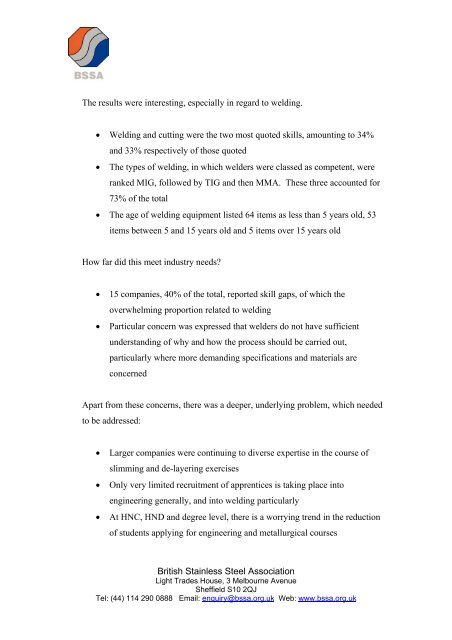The Welding of Stainless Steels - British Stainless Steel Association
The Welding of Stainless Steels - British Stainless Steel Association The Welding of Stainless Steels - British Stainless Steel Association
The results were interesting, especially in regard to welding. • Welding and cutting were the two most quoted skills, amounting to 34% and 33% respectively of those quoted • The types of welding, in which welders were classed as competent, were ranked MIG, followed by TIG and then MMA. These three accounted for 73% of the total • The age of welding equipment listed 64 items as less than 5 years old, 53 items between 5 and 15 years old and 5 items over 15 years old How far did this meet industry needs? • 15 companies, 40% of the total, reported skill gaps, of which the overwhelming proportion related to welding • Particular concern was expressed that welders do not have sufficient understanding of why and how the process should be carried out, particularly where more demanding specifications and materials are concerned Apart from these concerns, there was a deeper, underlying problem, which needed to be addressed: • Larger companies were continuing to diverse expertise in the course of slimming and de-layering exercises • Only very limited recruitment of apprentices is taking place into engineering generally, and into welding particularly • At HNC, HND and degree level, there is a worrying trend in the reduction of students applying for engineering and metallurgical courses British Stainless Steel Association Light Trades House, 3 Melbourne Avenue Sheffield S10 2QJ Tel: (44) 114 290 0888 Email: enquiry@bssa.org.uk Web: www.bssa.org.uk
• For many companies, skills acquisition and retention is therefore a matter of recruiting from a diminishing pool of term-served engineers and welders • Companies are therefore relying less on sending employees on external training courses, but are relying more on “topping up” the required skills in-house, when required Against this background, what sources of training are available? Colleges continue to provide programmes for the basic training of engineering apprentices, including welders. However, there is declining demand and this, combined with commercial pressures, is reducing the number of colleges both willing and able to provide training in more advanced materials such as stainless steel. I add the word “able”, because a member of staff of one college, which continues to provide a welding course, told me that his students have to be given exemptions from the practical examination in stainless steel welding, because the college cannot afford to provide samples for the students to weld Universities continue to provide higher academic qualifications, but the declining numbers of students applying for courses in engineering and metallurgy is widely recorded. It is also, by all accounts, increasingly difficult for lecturers to provide more than a very general introduction to basic materials. Stainless steels appears to face a particularly difficult hurdle, as it is not regarded as a separate material, like aluminium, for example, but as a niche steel – interesting, but esoteric! The most frequent source of company training is a competent colleague within the organisation, representing 35% of the sources mentioned, compared with 22% for colleges and universities. Qualified instructors were mentioned in only 12% of cases, the remainder representing the time-honoured approach of ‘learning from Nellie’, in other words from someone who may or may not be proficient, and who may or may not be capable of developing skills in someone else British Stainless Steel Association Light Trades House, 3 Melbourne Avenue Sheffield S10 2QJ Tel: (44) 114 290 0888 Email: enquiry@bssa.org.uk Web: www.bssa.org.uk
- Page 1 and 2: The Welding of Stainless Steels - D
- Page 3: not only different, but difficult t
- Page 7 and 8: Secondly, this problem is not uniqu
- Page 9: e. Lastly, those of us in the indus
<strong>The</strong> results were interesting, especially in regard to welding.<br />
• <strong>Welding</strong> and cutting were the two most quoted skills, amounting to 34%<br />
and 33% respectively <strong>of</strong> those quoted<br />
• <strong>The</strong> types <strong>of</strong> welding, in which welders were classed as competent, were<br />
ranked MIG, followed by TIG and then MMA. <strong>The</strong>se three accounted for<br />
73% <strong>of</strong> the total<br />
• <strong>The</strong> age <strong>of</strong> welding equipment listed 64 items as less than 5 years old, 53<br />
items between 5 and 15 years old and 5 items over 15 years old<br />
How far did this meet industry needs?<br />
• 15 companies, 40% <strong>of</strong> the total, reported skill gaps, <strong>of</strong> which the<br />
overwhelming proportion related to welding<br />
• Particular concern was expressed that welders do not have sufficient<br />
understanding <strong>of</strong> why and how the process should be carried out,<br />
particularly where more demanding specifications and materials are<br />
concerned<br />
Apart from these concerns, there was a deeper, underlying problem, which needed<br />
to be addressed:<br />
• Larger companies were continuing to diverse expertise in the course <strong>of</strong><br />
slimming and de-layering exercises<br />
• Only very limited recruitment <strong>of</strong> apprentices is taking place into<br />
engineering generally, and into welding particularly<br />
• At HNC, HND and degree level, there is a worrying trend in the reduction<br />
<strong>of</strong> students applying for engineering and metallurgical courses<br />
<strong>British</strong> <strong>Stainless</strong> <strong>Steel</strong> <strong>Association</strong><br />
Light Trades House, 3 Melbourne Avenue<br />
Sheffield S10 2QJ<br />
Tel: (44) 114 290 0888 Email: enquiry@bssa.org.uk Web: www.bssa.org.uk



